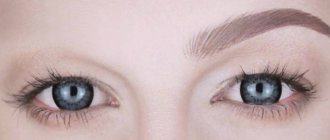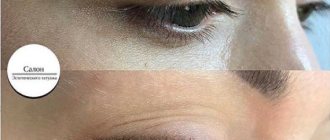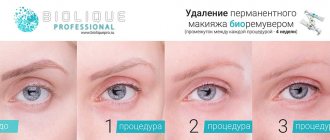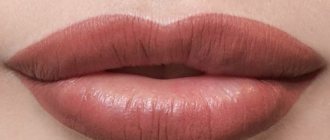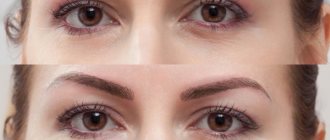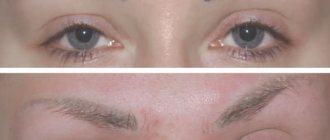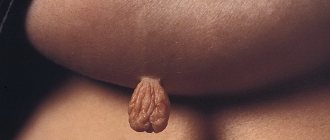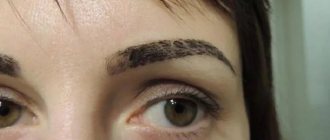Removing permanent tattoos is necessary not only in case of an unsuccessful procedure. Often you just need to remove the remnants of the old permanent in those places where it cannot be covered with a new one. We are lucky: modern methods of tattoo removal are much more gentle than they were at least 10 years ago. At that time, microdermabrasion was popular - mechanical peeling, in which pigment was literally cleaned out of skin cells. Of course, all this was painful and took a very long time to heal. Now there is no point in suffering like this, because there are more progressive and comfortable ways to remove tattoos: chemical and laser. Although some salons still offer good old microdermabrasion - apparently, for those who love the thrill.
In what cases is it necessary to reduce pigment?
Keep in mind! Laser tattoo removal may be required in the following situations:
- The client no longer liked the eyebrows this way. Cosmetologists often hear that a person has no complaints about the work itself. But fashion has changed, and now either a different tattoo or no tattoo is required.
- The paint was chosen poorly. This problem occurs more often, since even an experienced specialist selects tones and shades “by eye” or according to special tables, mixing several dyes. But a lot depends not only on the accuracy of the proportions, but also on how the pigment will react with the skin and be distributed under it. And the color may not turn out the way you would like, and adjustments do not help fix it.
- Incorrectly selected shapes and contours . Sometimes the client does not listen to the specialist’s advice and insists that one form or another suits him better. At the same time, a person cannot perceive himself objectively. It’s even worse when the master and the client compromise, and then the result is something average, but in any case not what is needed.
- The eyebrows turned out to be asymmetrical . This could be either a mistake by the artist or the result of improper distribution of the pigment.
- There is constant pain in the tattooed areas. This phenomenon is rare, and it can be either a sign of a late-onset allergy or a reaction of overly sensitive tissues to the paint.
Note! Regardless of the reason, laser removal is not performed immediately on the day of treatment.
The specialist conducts a preliminary examination, offers possible solutions to the problem, and if they are truly absent, a date is set for the procedure .
What determines the effectiveness of the procedure?
The result of tattoo removal is largely determined by the skills of the artist. However, the result does not always depend only on the specialist. Five contributing factors have a significant impact.
Pigment composition
Most paints contain titanium dioxide. This is a white mineral dye that is harmless to the body. If the pigment contains too much titanium dioxide, it will lose its saturation over time, leaving only a white-yellow tint on the skin.
Titanium dioxide molecules are large and heavy. They fit tightly and are difficult to cover or remove. When removing an old tattoo with a laser, a color inversion occurs: white becomes gray, but does not disappear. Therefore, they practically do not work with lasers with such paints. To do this, use a remover. However, the process is still long and complicated.
Depth and density of pigment introduction
The deeper and more saturated the paint is, the more difficult it will be to remove the tattoo. Modern techniques involve surface work that can be easily removed if necessary. You can remove powder eyebrows with a laser in just 1-2 sessions. Paint lips using watercolor technique - in 2-3 sessions.
However, effective removal of deep permanent tattoos requires longer work. Especially if an inexperienced master worked incorrectly and drove the pigment too deep. In such a situation, a long-term intervention of seven or more sessions will be required.
Pigment shade
The most difficult tones to work with are light, beige, yellow, and white. They cannot be removed with a laser, as the device does not recognize them. At best, the result is almost invisible. At worst, the color darkens, becomes grayish, greenish. Chemical methods are used to remove skin tones.
The easiest tones to remove are dark ones. That's why you shouldn't camouflage an old tattoo with light colors. It will be very difficult to remove such paint in the future.
Skin color and age
The easiest way to remove pigment with a laser is from light skin. The dark skin absorbs the energy beam, reduces efficiency, and increases the number of procedures.
Young skin recovers faster. Regeneration accelerates paint removal and healing. Metabolic processes of aging skin occur more slowly. Especially if there are scars on it after unsuccessful procedures. Therefore, more sessions will be required to fully remove the color.
Duration of the procedure
Dealing with old tattoos that tend to turn into light, greenish or yellowish shades is extremely difficult. A laser is not suitable for this type of work. Often a series of sessions are carried out using a remover or methods are combined.
Advantages and disadvantages of the method
The advantages of laser tattoo removal are:
- speed of the procedure (this may take no more than half an hour);
- low morbidity;
- no need for serious preparation;
- high efficiency.
But the method is not without its drawbacks , including:
- the need for mandatory several sessions ;
- high price ;
- the impossibility of completely removing some light dyes that are resistant to laser.
It is worth noting! As for pain, this aspect is not reflected in either disadvantages or advantages, since everyone endures the procedure individually.
Some people describe the sensation as a slight tingling sensation that is not even uncomfortable, while others feel pain and cannot tolerate the procedure without anesthesia.
Removing tattoos with a remover
This method is suitable for the entire range of pigments. The mechanism of its action is as follows: the components of a special composition for removing tattoos (removers) are mixed with the pigment and together with it are pushed to the surface. In this case, skin damage is also present, but not thermal, but chemical. But as with laser removal, the depth of treatment is too shallow to do any harm. The pigment comes out and is removed along with the crusts.
The formula of any remover is based on a mixture of acids that destroy the top layer of skin and promote its regeneration. Chemical peels work on exactly the same principle.
To completely remove the permanent, several sessions will be required at intervals of 3-4 weeks.
Post-procedure care is the same as for laser removal. The crusts must not be torn off, wetted, or cosmetics applied on top. But it is not recommended to use wound-healing agents - they affect the rate of release of pigment from skin cells.
The relative disadvantage of this method is the large, one might even say huge, difference in results when using different compositions. Now there are many types of tattoo removers on the market - American, European, Indian brands. Some do a great job, others don't. Because of this, there are more controversial reviews about chemical removal than laser removal. Although in fact, a high-quality remover works no worse.
Do eyebrows grow after removal?
There is a myth that hair stops growing after laser treatment.
Know! This opinion was partly born from the fact that the hairs exposed to the beam are completely discolored, and if the eyebrows are already very sparse, then it looks as if the hair has really been “burned out.”
In fact, the laser does not affect the intensity of hair growth or the hair itself , but the color will have to be restored by subsequent dyeing.
And the hairs that grow over time will still find their natural color.
How many sessions will it take?
The number of sessions of laser treatment for tattooing that will be needed for removal is influenced by a combination of factors:
- Depth of paint penetration: if the application was superficial, it will take only 3-4 sessions to remove the pigment outward.
- Pattern color: light is removed in 3 sessions, dark or multi-colored in 6-8.
- Skin injury during permanent application. If it is severely damaged, laser radiation during removal will damage the epidermis more, and the removal procedure will slow down.
- Pigment density: loose pigment is removed in 3 sessions, more saturated ones require 6-7 or more.
- Duration of wearing the tattoo.
- Skin color - dark skin rejects paint more easily, on light skin it is more noticeable and lasts longer.
- Body characteristics: functioning of the sebaceous glands, pain threshold, previous experience in tattoo removal or permanent makeup.
A specialist is rarely able to determine by eye how many laser procedures will be required. Usually clarity appears after the first two.
Recovery period
The laser beam does not violate the integrity of the skin, but it affects internal tissues .
Externally, after the procedure, you can only notice swelling and slight redness in the treatment area, and only in rare cases small bleeding wounds may appear, but they heal quickly.
The next day, a film or crust forms on such places , which cannot be peeled off yourself.
How the procedure works
Tattoo removal is carried out with a high-tech laser. It destroys pigments. After this, small fragments are excreted with lymph. The procedure is carried out under sterile conditions: it is completely safe for health. An allergic reaction is excluded.
How to get rid of boring makeup?
Let's look at it step by step.
Sign up for a consultation and first procedure. The number of sessions is individual and depends on the skin type, type of tattoo, pigment color and depth of its insertion. Only a master and only during an in-person examination can determine the required number of procedures.
Wait . There is a break between removal procedures. It is needed to restore and remove pigment from the skin.
Visit the specialist on schedule. After several procedures, the pigment will be completely removed from the skin.
Removal is a painless procedure. Clients usually feel a tingling and warm feeling. You will have to endure fixation of the eyelids or lips. Getting a tattoo is a more unpleasant procedure.
Cuts and mechanical damage to the skin are excluded. Swelling is possible after the procedure, but it goes away within a day. This is due to the work of the lymphatic system and is a natural process. There is no need to relieve swelling; give the body time to cope with the task on its own.
If the PM procedure was performed poorly and the skin was injured, which subsequently became voluminous to the touch, then the pigmentation will come out, but the scar relief, alas, will remain. This is not related to laser exposure.
Contraindications and possible consequences
Important! Laser tattoo removal is contraindicated for the following pathologies:
- allergy to laser (extremely rare);
- severe cardiovascular diseases;
- eczema, psoriasis and other dermatological diseases in which the rash spreads to the eyebrows;
- diabetes;
- cancer diseases;
- tendency to form scar tissue at the site of wounds;
- lichen;
- dermatitis;
- period of pregnancy and breastfeeding.
It is believed that laser removal is low-traumatic and does not have a serious negative effect on the skin.
But with individual negative reactions of the body, such a procedure can contribute to the development of certain complications :
- scar formation;
- severe swelling;
- redness;
- complete lightening of eyebrow hair.
It is worth noting! In some cases, swelling and internal hematomas are not too severe, but the tissue takes an unusually long time to recover.
In such cases, repeat sessions are scheduled at intervals of 4 weeks or more.
WHEN IS IT NEEDED TO REMOVE A TATTOO?
Of course, permanent makeup is a very convenient way to look attractive every day. And at the same time, do not spend a lot of time applying makeup. But there are times when tattoos need to be removed efficiently without leaving any traces. Such reasons may be:
- poor-quality application of permanent makeup;
- poorly chosen shape of eyelids, eyebrows, lips;
- a radical change in the client’s image;
- going out of fashion of a previously applied form of tattooing;
- the emergence of new, better permanent makeup techniques.
| No burns, scars or scars. After the procedure there is only slight redness. Before the procedure, I use cooling to make the session painless and quick. Active sun is not a problem; it is enough to apply a solar filter spf 30-50 to the place of information. |
Reviews
Below are some reviews. If you have something to say, leave your feedback in the comments below the article, it will be useful to our readers.
“I initially got a tattoo as an experiment , and I had no desire to wear it for several years, so I had to have laser removal .
The procedure was very painful , despite the anesthesia.
I went through four sessions, but I couldn’t completely remove all the pigment , and if I’m without makeup, traces of tattooing can be seen even when standing a couple of meters away from me.”
Yulia Batalina, 24 years old.
“I really
wanted a tattoo , and after looking at beautiful photos on the Internet, I took the risk of going to a rather expensive salon. The result was not just unexpected - it was terrible , and as it turned out later, it was due to the unprofessionalism of the master .the removal done at the expense of the same salon, and I am very glad that in two sessions they managed to almost completely remove the tattoo (only I myself, by looking closely, can see small traces of it).”
Olga Ukraintseva, Michurinsk.
Pros and cons of using a laser for tattooing
When deciding on permanent lip or eye makeup, you need to understand: it will be difficult to remove the results of a specialist’s work - the paint is deeply absorbed, and if the tattoo is unsuccessful or gets boring, it will have to be burned out with a laser beam.
Removing pigment is a long, painful process that requires careful post-procedure care and expense.
Advantages:
- Easy removal of old tattoos of dark shades - any paint darkens as it is absorbed into the epidermis, it is difficult to get rid of ingrained pigment, but laser radiation copes with this task.
- There are no visible long-term consequences - the beam acts gently, adjusting the tone of the ink. During the manipulation, burns, deep wounds, scars, and cicatrices are not formed.
- Complete healing and restoration of the skin lasts from 10 days to two weeks. Considering that after a painting procedure in a beauty salon, the skin takes a month to recover, then the dried crust falls off - recovery in less than two weeks is impossible.
- The paint comes out completely in two removal procedures.
The disadvantages of laser manipulation are pain, the use of anesthesia during the session, and is not suitable for tattoos done in light colors.
AFTER THE LASER TATTOO REMOVAL PROCEDURE
- Treat the area with panthenol (2 weeks, 2 times a day, unless otherwise prescribed by your doctor)
- Wear a patch to prevent friction of the treated area on clothing (3 days, unless otherwise prescribed by your doctor)
- Do not sunbathe (4 weeks, unless otherwise prescribed by your doctor)
- Do not perform cosmetic procedures in the tattoo area
- Avoid visiting the sauna and swimming pool (2 weeks, unless otherwise prescribed by your doctor)
- Use sunscreen SPF30-50 if exposed to the sun
Removing tattoos with a laser requires serious skills and medical education from a specialist. Sometimes, in an effort to get a cheaper service or in response to advertising and simply not having sufficient information, patients turn to non-professionals for tattoo removal. It is important to know that if you use unprofessional and cheap laser equipment, there is a risk of serious injury and very unpleasant and irreversible consequences: blisters, infection and irreversible scars.
Video from the ETV+ channel about the dangers of unprofessional tattoo removal: Low-power and cheap “Chinese” laser devices do not have enough power to destroy the pigment, so to get the effect, their power has to be concentrated in a very small point and “keep” the beam on the skin longer. Often the radiation from such lasers itself is not pure. As a result, severe overheating of the tissues occurs and a banal burn occurs with all the ensuing consequences.
Attention! There is an opinion on the Internet that after tattoo removal, blisters on the skin and strong crusts are a natural reaction to the procedure. This is not true. A severe burn or blisters after a laser tattoo removal procedure is not the norm, but a sign of a poorly performed procedure, a direct risk of scarring and the possibility of infection. This can and should be avoided.
As an example, here are a few photos of complications after tattoo removal (caution! photo 18+) with the consequences of tattoo removal using cheap devices and inexperienced so-called. “specialists” (photos belong to the Vitaclinica, some of the photos belong to our colleagues at the Laser Medicine Clinic of Dr. Mikryukov).
Margarita Raag (lapsehoolduspuhkusel)
medõde-kosmeetik
Broneeri aeg
Tagged raag | Comments to Margarita Raag (lapsehoolduspuhkusel) are disabled
Dr. Alexander Uskov
MD, PhD, CEO
Broneeri aeg
Tagged uskov-kell, uskovkell | Comments on the post Dr. Alexander Uskov disabled
According to statistics, approximately every fifth tattoo would like to be removed or changed. The average age of a patient coming to have a tattoo removed in Tallinn is 30 years.
The most common reasons for tattoo removal are:
- A tattoo of poor quality from an aesthetic point of view
- The desire to change (interrupt) a tattoo
- Changes in personal life
- Career or job related requirements
- Birth of children
How does the removal work?
The procedure for removing pigment is unpleasant, so local anesthesia is used to avoid pain for the patient. Most often, anesthetics are used in the form of a cream; the drug is applied to the eyebrows and left for 10-15 minutes for the product to take effect. You need to be prepared that local anesthesia will not completely desensitize the skin; some discomfort may be felt during the session.
Before turning on the device, you must protect your eyes from the laser. Therefore, the eyelids are covered with special safety glasses.
The pigment removal session does not last long , usually the cosmetologist needs 5-10 minutes. The laser beam is directed at the area being treated; care must be taken to ensure that one area of skin is not irradiated for too long. During the session there is a burning sensation, tingling sensation, and lacrimation may begin.
Possible complications
When hair coloring is done only with the original pigment and removed with a two-wave neodymium laser, the desired result will appear quickly and without problems. The time and complexity of the laser tattoo removal procedure depends on the coloring agent used by the artist.
The laser beam affects titanium dioxide found in colorants and iron oxide. The laser affects the pinkish and brown shades of the tattoo. This can cause darkening of the pigment area:
- o beige, matte pink pigments change color to dark gray;
- o white and dense beige can turn into black;
- o blue and green colors will turn black.
This is not the only side effect after laser tattoo removal. There are natural reactions of the body to laser exposure:
- swelling after laser removal;
- redness of the integument;
- change in hair shade.
These are temporary deteriorations, they pass quickly and do not need to be treated. To relieve swelling, apply chlorhexidine-based compresses or cooling lotions. This is simple care.
A more significant complication is the occurrence of discomfort and pain in the eyebrows. In these situations, after tattoo removal, experts recommend the following care: use ointments and creams with a healing effect: Panthenol, Bepanten, Solcoseryl. But it is better to discuss the use of such drugs with a cosmetologist in order to avoid unwanted consequences for the body.
The most unforeseen and severe consequences occur when tattoo removal is carried out at home, using outdated equipment or an illiterate specialist. This may cause:
- bruises;
- scars, scars;
- dark spots.
If you feel bad, it is recommended to seek help from a specialist cosmetologist or doctor and ensure good eyebrow care. You should not turn a blind eye to the painful sensations that arise after the laser.
Types of laser systems: which one is better?
Cosmetology clinics can use different types of laser machines, including outdated models. It is important to remember that not every type of laser can ensure the safety and effectiveness of the process. The most commonly used lasers in this area are ablative and non-ablative lasers. In the first case, we are talking about the technology of exposure to a laser beam (grinding), during which the pigment evaporates.
Non-ablative lasers destroy the pigment, and its further removal from the tissues is ensured by the body itself. Minimally invasive non-ablative lasers are more often used to remove tattoos: they have a less traumatic effect. Non-ablative laser systems differ in pulse length (the shorter the wave pulse, the safer the laser is for the skin).
The minimum pulse length level for lasers in modern expert-level clinics is calculated in nanoseconds. However, there is also more modern equipment - picosecond laser systems with ultrashort pulses lasting only 1 trillionth of a second. An example of such a setup is PicoCare.
This picolaser is one of the most expensive types of equipment in laser hardware cosmetology (average price - 18-20 million rubles). Thanks to the ultra-short pulse duration, it has a more gentle effect on the skin, which reduces pain to a minimum. The PicoCare picosecond laser is used not only for tattoo removal: it is used to remove stretch marks, scars and other skin defects, it is also actively used in anti-aging therapy.
